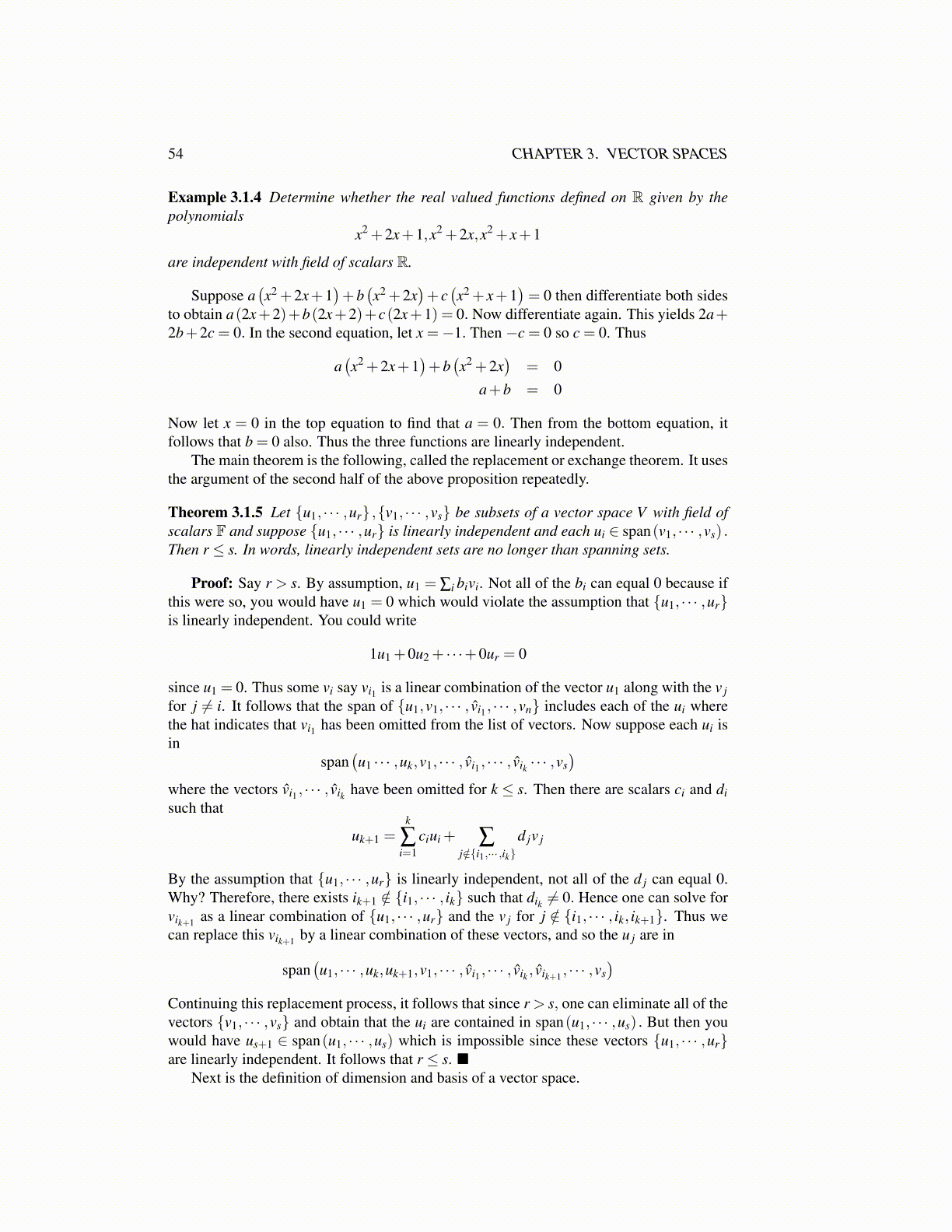
54 CHAPTER 3. VECTOR SPACES
Example 3.1.4 Determine whether the real valued functions defined on R given by thepolynomials
x2 +2x+1,x2 +2x,x2 + x+1
are independent with field of scalars R.
Suppose a(x2 +2x+1
)+b(x2 +2x
)+ c(x2 + x+1
)= 0 then differentiate both sides
to obtain a(2x+2)+b(2x+2)+c(2x+1) = 0. Now differentiate again. This yields 2a+2b+2c = 0. In the second equation, let x =−1. Then −c = 0 so c = 0. Thus
a(x2 +2x+1
)+b(x2 +2x
)= 0
a+b = 0
Now let x = 0 in the top equation to find that a = 0. Then from the bottom equation, itfollows that b = 0 also. Thus the three functions are linearly independent.
The main theorem is the following, called the replacement or exchange theorem. It usesthe argument of the second half of the above proposition repeatedly.
Theorem 3.1.5 Let {u1, · · · ,ur} ,{v1, · · · ,vs} be subsets of a vector space V with field ofscalars F and suppose {u1, · · · ,ur} is linearly independent and each ui ∈ span(v1, · · · ,vs) .Then r ≤ s. In words, linearly independent sets are no longer than spanning sets.
Proof: Say r > s. By assumption, u1 = ∑i bivi. Not all of the bi can equal 0 because ifthis were so, you would have u1 = 0 which would violate the assumption that {u1, · · · ,ur}is linearly independent. You could write
1u1 +0u2 + · · ·+0ur = 0
since u1 = 0. Thus some vi say vi1 is a linear combination of the vector u1 along with the v jfor j ̸= i. It follows that the span of {u1,v1, · · · , v̂i1 , · · · ,vn} includes each of the ui wherethe hat indicates that vi1 has been omitted from the list of vectors. Now suppose each ui isin
span(u1 · · · ,uk,v1, · · · , v̂i1 , · · · , v̂ik · · · ,vs
)where the vectors v̂i1 , · · · , v̂ik have been omitted for k ≤ s. Then there are scalars ci and disuch that
uk+1 =k
∑i=1
ciui + ∑j/∈{i1,··· ,ik}
d jv j
By the assumption that {u1, · · · ,ur} is linearly independent, not all of the d j can equal 0.Why? Therefore, there exists ik+1 /∈ {i1, · · · , ik} such that dik ̸= 0. Hence one can solve forvik+1 as a linear combination of {u1, · · · ,ur} and the v j for j /∈ {i1, · · · , ik, ik+1}. Thus wecan replace this vik+1 by a linear combination of these vectors, and so the u j are in
span(u1, · · · ,uk,uk+1,v1, · · · , v̂i1 , · · · , v̂ik , v̂ik+1 , · · · ,vs
)Continuing this replacement process, it follows that since r > s, one can eliminate all of thevectors {v1, · · · ,vs} and obtain that the ui are contained in span(u1, · · · ,us) . But then youwould have us+1 ∈ span(u1, · · · ,us) which is impossible since these vectors {u1, · · · ,ur}are linearly independent. It follows that r ≤ s. ■
Next is the definition of dimension and basis of a vector space.